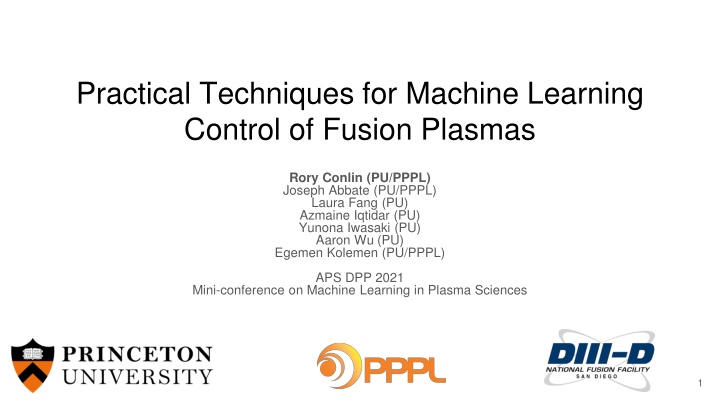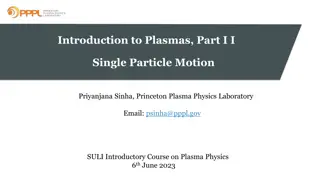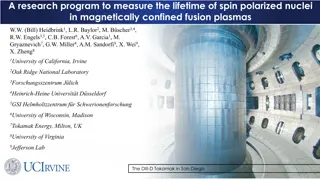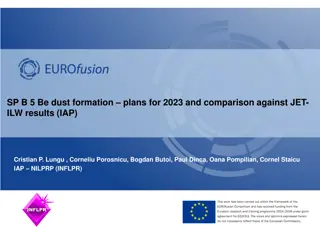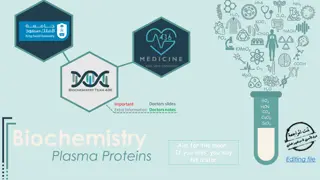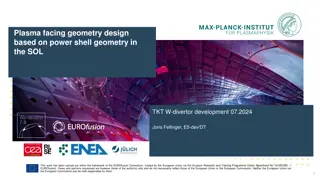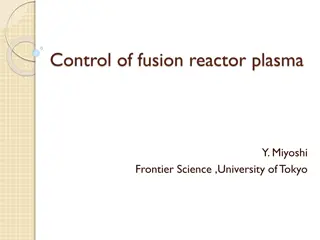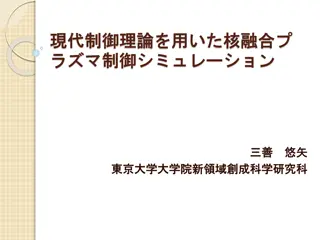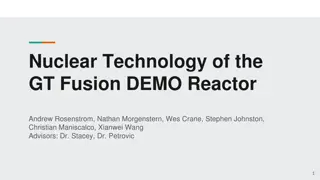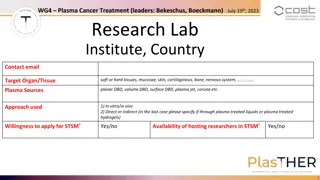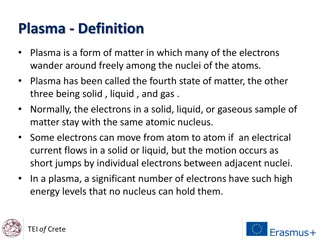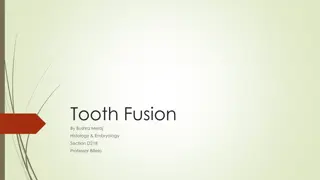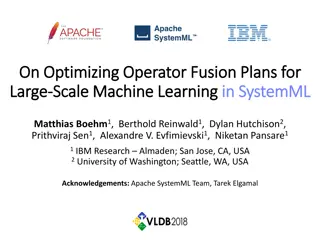Practical Machine Learning Techniques for Fusion Plasma Control
This presentation discusses the use of machine learning for controlling fusion plasma states, covering topics such as control-oriented modeling, neural networks for plasma dynamics, linearization techniques, and applying linear control laws in latent states for efficient control. The focus is on leveraging machine learning to simplify controller design and improve predictive performance in plasma dynamics.
Download Presentation

Please find below an Image/Link to download the presentation.
The content on the website is provided AS IS for your information and personal use only. It may not be sold, licensed, or shared on other websites without obtaining consent from the author.If you encounter any issues during the download, it is possible that the publisher has removed the file from their server.
You are allowed to download the files provided on this website for personal or commercial use, subject to the condition that they are used lawfully. All files are the property of their respective owners.
The content on the website is provided AS IS for your information and personal use only. It may not be sold, licensed, or shared on other websites without obtaining consent from the author.
E N D
Presentation Transcript
Practical Techniques for Machine Learning Control of Fusion Plasmas Rory Conlin (PU/PPPL) Joseph Abbate (PU/PPPL) Laura Fang (PU) Azmaine Iqtidar (PU) Yunona Iwasaki (PU) Aaron Wu (PU) Egemen Kolemen (PU/PPPL) APS DPP 2021 Mini-conference on Machine Learning in Plasma Sciences 1
Want to control plasma state Questions: How do we control profiles? Control oriented modelling via recurrent autoencoders Can we be confident in our modelling? Full state of plasma determined by 1D profiles: ML uncertainty analysis Pressure (P) Current (J) Electron temperature and density (Te, ne) Ion temperature and density (Ti, ni) Rotation (?) How do we infer the state of the plasma? ML driven dynamical state estimation 2
Control oriented modelling Neural nets can provide accurate models of plasma dynamics Abbate, Conlin, Nuclear Fusion, 2021 Highly nonlinear models difficult to control Number of possible actions grows exponentially with time horizon Expensive to search for optimal action, limited real time applicability Ideally want a simpler method for designing controller Could learn controller directly - ie Reinforcement Learning See GP11.00037, PP11.00150 Or take advantage of existing linear control theory Lots of methods for optimal, robust control design But need a linear model... 3
Plasma dynamics are nonlinear - use ML to get linear model Traditional linearization uses Jacobian of f Only valid locally (perhaps very locally) Alternative - Learn nonlinear embedding to linear space Learn Linearly Recurrent Autoencoder Network (LRAN) Can be valid globally S. E. Otto and C. W. Rowley, 2019 Mezic, 2019. 4
LRAN applied to profile prediction Model trained on experimental data from DIII-D 2013-2018 Similar predictive performance to other models cf Abbate, Conlin, 2021 5
Can apply linear control law in latent state Encode both current state xt zt and target state xref zref Apply standard linear control (eg LQR, H ) techniques to find input u Linear MPC framework is efficient (only requires solving small QP) Can easily incorporate actuator and state limits 6
Offline tests demonstrate proof of concept Test method zref xref Encoder z x MPC Controller u NN simulator Initial Target Planned online test during upcoming DIII-D campaign Autoencoder + MPC 7
Predictions without uncertainty dont mean much Bad How confident should we be? How to tell good from bad without knowing ground truth? Good 8
Train 2nd NN on magnitude of residuals Loss function: err = true - predicted If error > 0: loss = err2 If error < 0: loss = 0.1*err2 Uncertainty estimate usually requires ensemble or Bayesian NN expensive training and inference Instead, train 2nd NN to predict distance to true value Swoosh loss function similar to pinball for quantile predictions Trained to estimate 95% confidence interval, can be modified to any quantile 9
Confidence intervals overlap true values Scalar value Profile value 10
Uncertainty estimates are well calibrated Probability Density Predicted CDF matches well with true CDF Predicted uncertainty neither over- or under- estimated CDF of true errors Predicted uncertainties lead to well normalized errors CDF of predicted uncertainty 11
Prediction & Control requires accurate state estimate Beyond single diagnostic snapshot analysis Physics based models can be too slow / inaccurate Can use ML dynamics model to infer state between sensor measurements Bayesian inference too expensive for real time use ML to approximate Bayesian inference for combining multiple diagnostics Need efficient way to combine diagnostic information Need dynamical model to estimate between measurements 12
Use existing Autoencoder ODE to model dynamics Instead of discrete time model Output (measurement)is nonlinear function of state learn continuous time ODE: Want to compute Bayesian update to z given y very expensive UKF, particle filters, etc Can approximate using a NN Can integrate to predict state at any point in time 13
NN update can approximate Bayesian inference at low cost Still WIP, early results promising Bottleneck : training continuous time models is slow Limited parallelism, needs to be processed sequentially Learn by minimizing difference between prediction and measurement difference between NN update and true Bayesian update 14
Summary & Future Directions Other related talks/posters: Using NN to find linear models opens many new (old) doors for designing controllers TM10.00003 : Novel aggregate machine learning and transport modeling profile predictions UM10.00003 : Machine Learning for Real-time Fusion Plasma Behavior Prediction and Manipulation Can also generate accurate uncertainty estimates at low cost JP11.00140 : Uncertainty Quantification for Machine Learning Models in Plasma Physics Can incorporate into controller via H or PAC-Bayes framework GP11.00037 : Controlling Plasma Profiles in a Learned Model via Reinforcement Learning ODE based model has potential as basis for state observer ZP11.00011 : Neural Dynamical Systems: Balancing Structure and Flexibility in Physical Prediction Accurate estimates needed for good control 15
